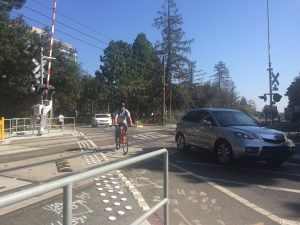Palo Alto City Council candidates are pushing for federal and state help to fund the construction of grade separations, which have become urgent in recent years due to increased congestion at the railroad crossings.
Palo Alto has four at-grade crossings where train tracks intersect with roads at the same elevation – Palo Alto Avenue, Churchill Avenue, Meadow Drive and Charleston Road – impacting traffic and, in extreme cases, causing accidents.
A recent accident on Oct. 24 at the Ravenswood Avenue grade crossing in nearby Menlo Park highlighted the danger. A woman said she was nearly “killed by a train” when her car got caught on the tracks. She was unable to move due to backed up traffic, the local news site Patch reported.
At an Oct. 4 election forum, Palo Alto City Council candidates stressed the need to tap into funds at the state and federal level. The city wants to prevent scenarios like the one that occurred at Ravenswood Avenue and hopes to address traffic congestion.
Officials are considering closing Palo Alto Avenue to car traffic and creating alternative ways for bicyclists and pedestrians to cross. The options for Churchill Avenue are closing the crossing to traffic or raising the road slightly and lowering the tracks.
For the Meadow Drive and Charleston Road crossings officials are considering raising the tracks tracks and slightly depressing the road. The much more expensive option under consideration is building a tunnel beneath the roadways for trains to pass through.

“Palo Alto and the peninsula are kind of an economic powerhouse for the entire country, so I think we need to get creative about our financing,” Councilman Tom Dubois said. “It’s not something that Palo Alto by itself should have to fund in its entirety.”
City Councilman Cory Wolbach, who is also chairman of the council’s Rail Committee, said building trenches and tunnels are a viable option.
Vice Mayor Eric Filseth favored a less expensive option for the city – saying that the tunneling option could cost the city $2-$4 billion.
Filseth didn’t specify which grade separation option he prefers.
Pat Boone, who is running for City Council, agreed with Filseth on tunneling being an expensive option and said, “I also think we need to look at federal dollars and also state dollars. We have to be creative in our funding for this.”
Grade separations have become a hot topic for the city council and the Palo Alto community as traffic has worsened.
Caltrain’s electrification of rails is expected to increase backups during peak times when there could be up to 20 trains passing per hour, according to the city’s website.
“That would mean that gates at rail intersections would be down 25 percent of the time during daily peak periods. Traffic congestion would double by 2030,” the city reported earlier this year.
Some council members believe the lack of grade separations could impact neighboring cities.
“In order for Caltrain to run more service in the future, in my view, there can’t be any at-grade crossings. And getting to zero at-grade crossings on the corridor is going to be a herculean task,” Wolbach said in an interview. “Caltrain, our state legislators, the three counties and all the cities, I think, are going to have to work together to achieve that goal.”
The city council is trying to avoid the potential traffic jams, accidents and delayed services, which can affect nearby cities on the same Caltrain corridor.
With so much at stake, Palo Alto’s government and residents feel the pressure. Candidates Wolbach and DuBois emphasized the importance of community interest and participation.
The city council created a Citizen’s Advocacy Panel (CAP) for the community’s input on the grade separations project, but those efforts may not be enough.
The CAP, which started meeting in August, consists of 12 people selected from the community to advise the city staff and city manager on grade separations. Nadia Naik, Palo Alto resident and CAP member, said the city could do a better job of incorporating the panel into the decision-making process.
“I thought we needed to have an empowered stakeholder group,” Naik said. “By empowered, I meant that we should be coming to consensus recommendations, right? And that’s specifically not happening.”
A decision on the course of action will be made by the end of 2018.
Palo Alto hopes to start construction by 2023, which will put it on track to have the project completed by 2029 – right in time to deal with the doubling of traffic congestion the city has estimated for 2030.
